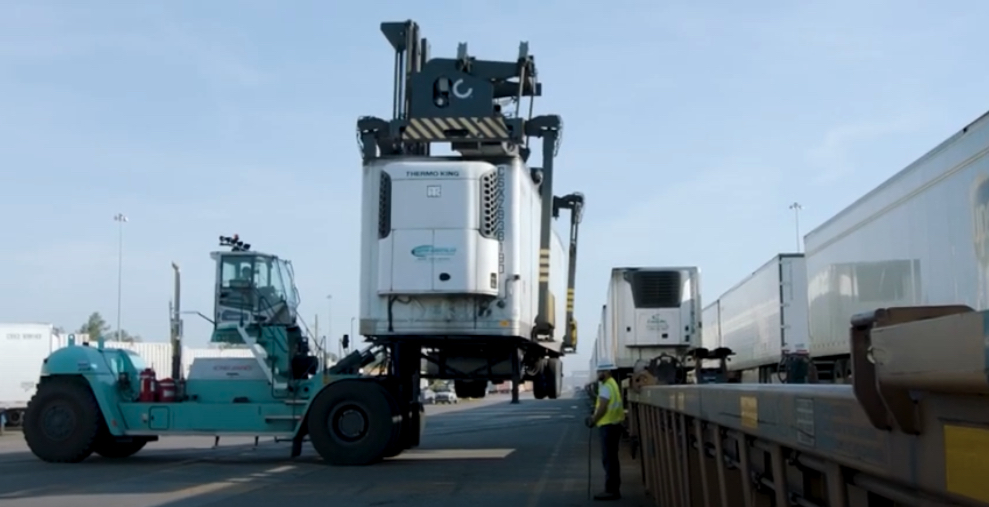
BALTIMORE – If you buy a Florida-grown watermelon in the New York City area, there’s a good chance that it rode a CSX Transportation intermodal train from the Sunshine State to the Northeast.
CSX has become the largest hauler of Florida watermelons to the Northeast thanks to a year-old experiment dubbed CSX Greenway, a premium door-to-door trailer-on-flatcar service.
Today CSX is operating a fleet of more than 100 refrigerated trailers that carry produce, frozen food, and agricultural products grown or produced in Florida and southern Georgia. The trailers with CSXZ reporting marks ride trains I031 and I032 between Jacksonville, Fla., and North Bergen, N.J.
“Greenway Combines reliability of trucking with the economic advantages, capacity, and sustainability of rail,” Farrukh Bezar, the railroad’s senior vice president and chief strategy officer, told the North East Association of Rail Shippers last week.
CSX wants to expand the service, and test it in other lanes outside the I-95 corridor, but there’s a lag time for trailer orders due to ongoing supply chain disruptions.

“The plan is to continue to grow the business. The genesis behind it was how do you connect Florida to the consumption markets of the Northeast? For those of you who understand the trucking market, Florida is a nightmare for trucks,” Bezar says.
The state is overwhelmingly a consumption market, so truckers who bring southbound loads to the state rarely find backhaul loads for their return trips north.
CSX aims to haul loads in both directions, with produce northbound and temperature controlled goods or dry consumer goods moving southbound.
The small farmers and growers who use the service are attracted by rail’s environmental advantage over trucks. “They are very concerned and consumed with lowering their carbon footprint,” Bezar says.
The I-95 corridor along the East Coast is an underpenetrated intermodal market, partly because CSX can’t use more efficient double-stack trains due to the clearance restrictions of the Howard Street Tunnel in Baltimore. A clearance project is expected to be completed in late 2024, however, which will allow the railroad to better compete for business.
“We don’t take advantage of the I-95 corridor the way we should and could as a company,” Bezar says. “If you ever ride in your car from Miami up to Boston … you’re sitting in traffic all the time behind trucks. It’s amazing how many trucks are on the highway.”














Back in the old days. Produce from Florida came to Michigan useing three railroads. ACL, SAL or FEC, CC&O and C&O. That is at least three interchange points. When CSXT came about it became single line service from Florida to Michigan and the produce business went away. Why dosent CSXT enter is lane again? Rail to Detroit, truck to different areas or to Canada.
Sorry but, longer trains do not equate with ” good service”.
What’s the difference between CSX’s GreenWay and the OBS or Orange Blossom Special perishable train previously operated by CSX and Seaboard System in the 1980’s??
I would say a major difference is that GreenWay uses existing train service while the OBS was an added train. That’s a major cost saving for GreenWay.
CSX does provide expedited intermodal service between the northeast and Florida. They’re just developing it more now. That’s well and good and it’s puzzling as to why people are critical of what they’re doing.
Adding business to an existing schedule is far more economically efficient than running another train. Modern technology allows the more efficient longer trains. If those longer trains meet the market requirements, it’s preferable to operate the longer trains.
The whole idea is to get the most output while using the least input.
I thought CSX was going to establish a service triangle with Jacksonville, Kingsbury, Indiana and Rotterdam NY as the “3 points”.
They bring produce up from Jax to Kingsbury to serve the Chicago market, pickup the west coast fruit there and take it to Rotterdam, split the empties to go back to Jax and Chicago. Repeat and rinse.
I believe that was part of the Railex service that lost funding and had to be bailed out by the UP and is no longer.
The Railex triangle on CSX was East St Louis to Jax, Jax to Rotterdam, Rotterdam to Chicago. Repeat and rinse.
In an attempt to take it further, CSX set up their own triangle using Kingsbury.
Railex died because California died due to drought, it cut the reefer loads by two thirds. So UP sent them to Chicago instead, so it took 2 extra days to reach Jax blowing up the whole model. Railex shut down, UP bought the reefers, CSX cut the tracks in East St Louis ( O’Fallon) shortly thereafter.
Mr. Bezar should take a second look at his last statement:
“We don’t take advantage of the I-95 corridor the way we should and could as a company,” Bezar says. “If you ever ride in your car from Miami up to Boston … you’re sitting in traffic all the time behind trucks. It’s amazing how many trucks are on the highway.” and act on it.
There must be a MILLION trucks on that route every month, so why doesn’t CSX go after the freight that’s already out there clogging the highways!! The answer is simply, they don’t know how to and let’s face it, they really don’t want the business. Service sells itself, but not on 15,000 foot trains!
Thank you Mr. Jaworksi. You just captured the essence of true success in the intermodal business (or any service business). First, to quote one my TRAINS articles from about 20 years ago, “It’s the service stupid!” Second, CSX has zero brand identity and even less brand credibility in the marketplace. They have been stumbling and fumbling around in the intermodal business since about 1980 trying to figure out what they want to be when or if they finally grow up.
Train length doesn’t determine service quality.
Would behoove CSX to wait un acquiring new equipment until the work is done on the Howard Street tunnel, then they could just switch to 53′ refrigerated containers and skip buying more trailers. Yes, that’s two years of not growing the service, but they’ll eventually have to convert anyways. CSX and BN were both successful offering door to door intermodal products, through third parties and not directly to customers. CSX by combining the intermodal service of CSXI with the drayage of CMX, and BN through their BN America service, just that neither one really new how to price the service, had to make to many special rates instead of offering “book” rates that would just attract the service.
I respectfully disagree.
While double stack containers have a significant cost advantage on the rail, they also have a significant cost disadvantage on the highway. Remember, we’re talking intermodal movements here. Both rail and highway costs must be considered.
The disadvantage on the road comes from the highway weight limits. (80,000 lbs. with exceptions.) A container/chassis combination will weigh more than a trailer. Because the equipment weighs more the payload must weigh less.
In other words, if containers are used in lieu of trailers the over the road trucker can haul more payload per shipment than the railroad can. This gives said trucker a cost advantage if the railroad uses containers.
Fresh fruits and vegetables are mostly water, as in “Watermelons.” That means they load heavy and weight really counts.
The entirety of the trough costs must be considered. And that means containers won’t always be more efficient than TOFC trailers.
I meant “through costs”.
Unfortunately, operational realities may dictate double stack everywhere if the railroads are to continue in business. Most rail intermodal terminals in metropolitan areas like Chicago are landlocked with little if any room to expand. A good example is BNSF Willow Sprins. It is now operating close to capacity with mostly trailers. The only way it can expand is to go to all containers since you stack them 2-3 high in the terminal and 2 high on the trains. We concede for all the muckrakers in the audience this is not an ideal solution and brings its own set of problems. But try and find a workable realistic alternative.
There’s nothing new under the sun.
Ain’t that wonderful? Praise CSX’s growth effort to actually capture a market it already served in pre-PSR era.
It’s just that this time, “premium” service generally means a block of intermodal cars tacked at the rear of a 12000′ train that must work en route at Jacksonville, Waycross, Florence, Rocky Mount and Richmond, with 0.5hp per ton, one defective unit that won’t load, and a notch 6 restriction.
It will be interesting to see how this works out. Freight railroads do not have a great record of success when it comes to providing retail intermodal service. CSX is going to face the same challenges previous retail attempts faced. At Santa Fe we preferred to let our OTR partner J.B. Hunt handle the details (and significant challenges) of the retail trucking operation. We also partnered with leading refrigerated carriers like KLLM to handle the perishable business (since they already had the backhaul business in hand). This appeared to be a great formula for success. Ironically, we now see JB Hunt refrigerated containers on BNSF intermodal trains.
Wouldn’t this be a great niche for new refrigerated RoadRailers? Probably as efficient as you can get. Low-cost quick expandability possible too.
I’m with you, Richard. But the roadrailer service seems to be beset by narrow thinking. Every carrier that experimented with this very efficient concept couldn’t overcome the “one-size-fits-all” mentality of domestic containerization. Roadrailer is just too “different”.
Nobody in the entire world could make RoadRailers work economically. Not even Amtrak. And a whole lot of people, in several countries, sure tried.
Rail freight systems are networks that require interchangeable equipment. RoadRailers, as designed and promoted, were basically incompatible with existing equipment. That made them costly to operate and extremely limited as to where they could operate.
Nobody ever figured out how to move sea containers with RoadRailers.
I did work with RoadRailers. In fact, I worked for RoadRailer.
Not true:
https://railrunner.com/
Well, if the South Africans can make it work, more power to them.
But here in North America, Australia, etc. nobody could make it work.
Is the SA system a success in commercial service? That’s the real test. There have been several concepts and prototypes, but none have so far stood the test of the market.
I definitely agree with his comment about the trucks on I-95. When I drive from my house in PA to the Florida Keys I stay off of I-95 as much as I can. Unfortunately, from southern SC on down I really don’t have any other option. But anything that helps reduce trucks on I-95 should be encouraged.
Does the Tropicana juice train still operate?
Not really. Per Wikipedia, “In 2017 CSX abolished separate Juice Trains between Philadelphia and Florida. Tropicana products are now carried on other CSX trains to and from Florida. A separate train for Tropicana operates over the short distance north of Philadelphia.”
I suppose this was another example of the deleterious effects of PSR.
More like the deleterious effect of people moving here and land that once was citrus groves becoming housing. You don’t become the #3 state by population without giving something up.
FYI eyewitness account: although CSX does not run the juice train as such anymore, they do haul the Tropicana cars in other trains, and it’s not unusual to see a solid block of 20-30 of them in a fast mechndiser.
And I’ll suppose that it’s the result of a dramatic decline in the per capita consumption of orange juice.
CSX can’t haul it if Tropicana doesn’t ship it.